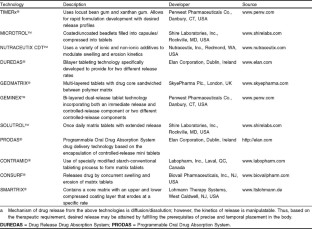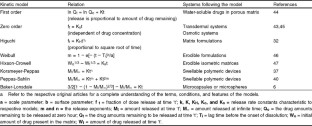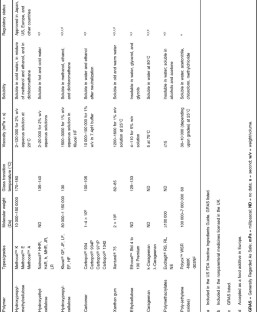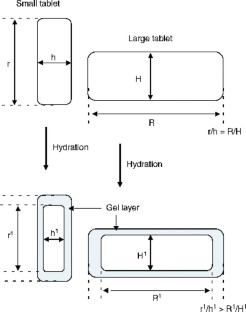Factors affecting mechanism and kinetics of drug release from matrix-based oral controlled drug delivery systems

Matrix technologies have often proven popular among the oral controlled drug delivery technologies because of their simplicity, ease in manufacturing, high level of reproducibility, stability of the raw materials and dosage form, and ease of scale-up and process validation. Technological advancements in the area of matrix formulation have made controlled-release product development much easier than before, and improved upon the feasibility of delivering a wide variety of drugs with different physicochemical and biopharmaceutical properties. This is reflected by the large number of patents filed each year and by the commercial success of a number of novel drug delivery systems based on matrix technologies.
Matrix-based delivery technologies have steadily matured from delivering drugs by first-order or square-root-of-time release kinetics to much more complex and customized release patterns. In order to achieve linear or zero-order release, various strategies that seek to manipulate tablet geometry, polymer variables, and formulation aspects have been applied. Various drug, polymer, and formulation-related factors, which influence the in situ formation of a polymeric gel layer/drug depletion zone and its characteristics as a function of time, determine the drug release from matrix systems.
Various mathematical models, ranging from simple empirical or semi-empirical (Higuchi equation, Power law) to more complex mechanistic theories that consider diffusion, swelling, and dissolution processes simultaneously, have been developed to describe the mass transport processes involved in matrix-based drug release. Careful selection of an appropriate model for drug release provides insight to the underlying mass transport mechanisms and helps in predicting the effect of the device design parameters on the resulting drug-release rate. Thus, a basic understanding of release kinetics and appropriate mechanisms of drug release from matrix system and their inter-relationships may minimize the number of trials in final optimization, thereby improving formulation development processes.
This is a preview of subscription content, log in via an institution to check access.
Access this article
Subscribe and save
Springer+ Basic
€32.70 /Month
- Get 10 units per month
- Download Article/Chapter or eBook
- 1 Unit = 1 Article or 1 Chapter
- Cancel anytime
Buy Now
Price includes VAT (France)
Instant access to the full article PDF.
Rent this article via DeepDyve






Similar content being viewed by others
Current Trends in the Development of Technologies for Matrix Formulations with Modified Release (Review)
Article 01 October 2016

Hydrophilic Matrix Dosage Forms: Definitions, General Attributes, and the Evolution of Clinical Utilization
Chapter © 2014

Critical Points in Biopolymeric-Controlled Release Matrix Systems
Chapter © 2020
Explore related subjects
Notes
The use of trade names is for product identification purposes only and does not imply endorsement.
References
- Chien YW. Controlled- and modulated-release drug-delivery systems. In: Swarbrick J, Baylan JC, editors. Encyclopedia of pharmaceutical technology. New York: Dekker, 1990: 281–313 Google Scholar
- Jeong SY, Kim SW, Eenink MJD, et al. Self-regulating insulin delivery systems (I): synthesis and characterization of glycosylated insulin. J Control Release 1984; 1: 57–66 ArticleCASGoogle Scholar
- Glucowatch [online]. Available from URL: http://www.glucowatch.com [Accessed 2003 Dec 16]
- Pillai O, Dhanikula AB, Panchagnula R. Drug delivery: an odyssey of 100 years. Curr Opin Chem Biol 2001; 5: 439–46 ArticlePubMedCASGoogle Scholar
- Soppimath KS, Kulkarni AR, Aminabhavi TM. Encapsulation of antihypertensive drugs in cellulose-based matrix microspheres: characterization and release kinetics of microspheres and tableted microspheres. J Microencapsul 2001; 18(3): 397–409 ArticlePubMedCASGoogle Scholar
- Baker R. Diffusion-controlled systems. In: Baker R, editor. Controlled release of biologically active agents. New York: John Wiley and Sons, 1987: 39–83 Google Scholar
- Gandhi R, Kaul CL, Panchagnula R. Extrusion and spheronization in the development of oral controlled-release dosage forms. Pharm Sci Technol Today 1998; 2(4): 160–70 ArticleGoogle Scholar
- Kararli TT, Hurlbut JB, Needham TE. Glass-rubber transitions of cellulosic polymers by dynamic mechanical analysis. J Pharm Sci 1990; 77: 845–8 ArticleGoogle Scholar
- Tahara K, Yamamoto K, Nishihata T. Overall mechanism behind matrix sustained-release tablets prepared with hydroxy propyl methyl cellulose 2910. J Control Release 1995; 35: 59–66 ArticleCASGoogle Scholar
- Touiton E, Donbrow M. Influence of additives on hydroxy ethyl methyl cellulose properties: relation between gelation temperature changes, compressed matrix integrity and drug release profile. Int J Pharm 1982; 11: 131–48 ArticleGoogle Scholar
- Colombo P, Bettini R, Santi P, et al. Swellable matrices for controlled drug delivery: gel-layer behavior, mechanisms and optimal performance. Pharm Sci Technol Today 2000; 3(6): 198–204 ArticlePubMedCASGoogle Scholar
- Karasulu HY, Ertan G, Kose T. Modeling of theophylline release from different geometrical erodible tablets. Eur J Pharm Biopharm 2000; 49(2): 177–82 ArticlePubMedCASGoogle Scholar
- Pharn AT, Lee PI. Probing the mechanisms of drug release from hydroxypropyl methylcellulose matrices. Pharm Res 1994; 11: 1379–84 ArticleGoogle Scholar
- Reynolds TD. Polymer erosion and drug-release characterization of HPMC matrices. J Pharm Sci 1998; 87(7): 1115–23 ArticlePubMedCASGoogle Scholar
- Nellore RV, Rekhi GS, Hussain AS, et al. Development of metoprolol tartarate extended release matrix tablet formulations for regulatory policy consideration. J Control Release 1998; 50: 247–56 ArticlePubMedCASGoogle Scholar
- Eddington ND, Rekhi GS, Nellore RV, et al. Development and internal validation of an in vitro-in vivo correlation for a hydrophilic metoprolol tartarate extended-release tablet formulation. Pharm Res 1998; 15: 466–71 ArticlePubMedCASGoogle Scholar
- Bettini R, Colombo P, Massino G, et al. Swelling and drug release in hydrogel matrices: polymer viscosity and matrix porosity effects. Eur J Pharm Sci 1994; 2: 213–9 ArticleCASGoogle Scholar
- Bettini R, Catellani PL, Santi P, et al. Translocation of drug particles in HPMC matrix gel layer: effect of drug solubility and influence on release rate. J Control Release 2001; 70(3): 383–91 ArticlePubMedCASGoogle Scholar
- Colombo P, Conte U, Gazzaniger A, et al. Drug release modulation by physical restriction of matrix swelling. Int J Pharm 1990; 63: 43–8 ArticleCASGoogle Scholar
- Colombo P, Bettini R, Massimo G, et al. Drug diffusion front movement is important in drug release control from swellable matrix tablets. J Pharm Sci 1995; 84(8): 991–7 ArticlePubMedCASGoogle Scholar
- Colombo P, Bettini R, Catellani PL, et al. Drug volume fraction profile in the gel phase and drug release kinetics in hydroxypropylmethyl cellulose matrices containing a soluble drug. Eur J Pharm Sci 1999; 9: 33–40 ArticlePubMedCASGoogle Scholar
- Colombo P, Bettini R, Peppas NA. Observation of swelling process and diffusion front position during swelling in hydroxypropyl methylcellulose matrices containing a soluble drug. J Control Release 1999; 61: 83–91 ArticlePubMedCASGoogle Scholar
- Ju RT, Nixon PR, Patel MV, et al. Drug release from hydrophilic matrices (II): a mathematical model based on the polymer disentanglement concentration and the diffusion layer. J Pharm Sci 1995; 84(12): 1464–77 ArticlePubMedCASGoogle Scholar
- Ju RT, Nixon PR, Patel MV. Drug release from hydrophilic matrices (I): new scaling laws for predicting polymer and drug release based on the polymer disentanglement concentration and the diffusion layer. J Pharm Sci 1995; 84(12): 1455–63 ArticlePubMedCASGoogle Scholar
- Ju RT, Nixon PR, Patel MV. Diffusion coefficients of polymer chains in the diffusion layer adjacent to a swollen hydrophilic matrix. J Pharm Sci 1997; 86(11): 1293–8 ArticlePubMedCASGoogle Scholar
- Harland RS, Gazzaniga A, Sangalli ME, et al. Drug/polymer matrix swelling and dissolution. Pharm Res 1988; 5(8): 488–94 ArticlePubMedCASGoogle Scholar
- Gao P, Meury RH. Swelling of hydroxypropyl methylcellulose matrix tablets (I): characterization of swelling using a novel optical imaging method. J Pharm Sci 1996; 85: 725–31 ArticlePubMedCASGoogle Scholar
- Fyfe CA, Blazek-Welsh AI. Quantitative NMR imaging study of the mechanism of drug release from swelling hydroxypropylmethylcellulose tablets. J Control Release 2000; 68: 313–33 ArticlePubMedCASGoogle Scholar
- Fyfe CA, Grondey H, Blazek-Welsh AI, et al. NMR imaging investigations of drug delivery devices using a flow-through USP dissolution apparatus. J Control Release 2000; 68(1): 73–83 ArticlePubMedCASGoogle Scholar
- Gao P, Fagerness PE. Diffusion in HPMC gels (I): determination of drug and water diffusivity by pulsed-field gradient spin-echo NMR. Pharm Res 1995; 12: 955–64 ArticlePubMedCASGoogle Scholar
- Yang L. Determination of continuous changes in the gel layer of poly(ethylene oxide) and HPMC tablets undergoing hydration: a texture analysis study. Pharm Res 1998; 15: 1902–6 ArticlePubMedCASGoogle Scholar
- Higuchi T. Mechanism of sustained action medication, theoretical analysis of rate of release of solid drugs dispersed in solid matrices. J Pharm Sci 1963; 52: 1145–9 ArticlePubMedCASGoogle Scholar
- Ford JL, Rubinstein MH, Hogan JE. Propranolol hydrochloride and aminophylline release from matrix tablets containing hydroxypropyl methylcellulose. Int J Pharm 1985; 24: 339–50 ArticleCASGoogle Scholar
- Ford JL, Rubinstein MH, McCaul F, et al. Importance of drug type, tablet shape and added diluents on drug release kinetics from hydroxy propyl methylcellulose matrix tablets. Int J Pharm 1987; 40: 223–34 ArticleCASGoogle Scholar
- Ford JL, Mitchell K, Sawh D, et al. Hydroxypropyl methylcellulose matrix tablets containing propranolol HCl and sodium dodecyl sulphate. Int J Pharm 1991; 71: 213–21 ArticleCASGoogle Scholar
- Hogan JE. Hydroxypropyl methylcellulose sustained release technology. Drug Dev Ind Pharm 1989; 15(6-7): 975–99 ArticleCASGoogle Scholar
- Korsmeyer RW, Gurny R, Doelker E, et al. Mechanisms of solute release from porous hydrophilic polymers. Int J Pharm 1983; 15: 25–35 ArticleCASGoogle Scholar
- Ritger PL, Peppas NA. A simple equation for description of solute release (I): Fickian and non-Fickian release from non-swellable devices in the form of slabs, spheres, cylinders or discs. J Control Release 1987; 5: 23–36 ArticleCASGoogle Scholar
- Rinaki E, Valsami G, Macheras P. The power law can describe the ‘entire’ drug release curve from HPMC-based matrix tablets: a hypothesis. Int J Pharm 2003; 255(1-2): 199–207 ArticlePubMedCASGoogle Scholar
- Peppas NA, Sahlin JJ. A simple equation for the description of solute release (III): coupling of diffusion and relaxation. Int J Pharm 1989; 57(2): 169–72 ArticleCASGoogle Scholar
- Siepmann J, Peppas NA. Modeling of drug release from delivery systems based on hydroxypropyl methylcellulose (HPMC). Adv Drug Deliv Rev 2001; 48(2-3): 139–57 ArticlePubMedCASGoogle Scholar
- Sood A, Panchagnula R. Role of dissolution studies in controlled release drug delivery systems. STP Pharma Sci 1999; 9(2): 157–68 CASGoogle Scholar
- Costa P, Lobo JMS. Modeling comparison of dissolution profiles. Eur J Pharm Sci 2001; 13: 123–33 ArticlePubMedCASGoogle Scholar
- Mulye NV, Turco ST. An examination of assumptions underlying the first-order kinetic model for release of water soluble drugs from dicalcium phosphate dihydrate matrices. Drug Dev Ind Pharm 1996; 22(7): 673–9 ArticleCASGoogle Scholar
- Varelas CG, Dixon DG, Steiner C. Zero-order release from biphasic polymer hydrogels. J Control Release 1995; 34: 185–92 ArticleCASGoogle Scholar
- Christensen FN, Hansen FY, Bechgaard H. Physical interpretation of parameters in the Rosin-Rammler-Sperling-Weibull distribution for drug release from controlled release dosage forms. J Pharm Pharmacol 1980; 32: 580–2 ArticlePubMedCASGoogle Scholar
- Hixon AW, Crowell JH. Dependence of reaction velocity upon surface and agitation. Ind Eng Chem 1931; 23: 923–31 ArticleGoogle Scholar
- Panchagnula R, Thomas NS. Biopharmaceutics and pharmacokinetics in drug research. Int J Pharm 2000; 201(2): 131–50 ArticlePubMedCASGoogle Scholar
- Amidon GL, Lennernas H, Shah VP, et al. A theoretical basis for a biopharmaceutic drug classification: the correlation of in vitro drug product dissolution and in vivo bioavailability. Pharm Res 1995; 12(3): 413–20 ArticlePubMedCASGoogle Scholar
- Efentakis M, Al-Hmoud H, Buchton G, et al. The influence of surfactant on drug release from hydrophobic matrix. Int J Pharm 1991; 70: 153–8 ArticleCASGoogle Scholar
- Rao VM, Haslam JL, Stella VJ. Controlled and complete release of a model poorly water-soluble drug, prednisolone, from hydroxypropyl methylcellulose matrix tablets using (SBE)(7m)-beta-cyclodextrin as a solubilizing agent. J Pharm Sci 2001; 90(7): 807–16 ArticlePubMedCASGoogle Scholar
- Giunchedi P, Maggi L, Manna AL, et al. Modification of the dissolution behavior of a water-insoluble drug, naftazine, for zero-order release matrix preparation. J Pharm Pharmacol 1999; 46: 476–80 ArticleGoogle Scholar
- Ford JL, Rubinstein MH, Hogan JE. Dissolution of a poorly water-soluble drug indomethacin from hydroxypropyl methylcellulose controlled-release tablets [abstract]. J Pharm Pharmacol 1985; 37: 33 ArticleGoogle Scholar
- Lalla JK, Bhat SU, Girappanavar DM. Controlled-release isosorbide dinitrate pellets (Pt II): in vivo studies. J Pharm Sci 1993; 82(12): 1292–5 ArticlePubMedCASGoogle Scholar
- Lalla JK, Bhat SU. Controlled-release isosorbide dinitrate pellets (Pt I): design and evaluation of controlled release capsule dosage form. J Pharm Sci 1993; 82(12): 1288–91 ArticlePubMedCASGoogle Scholar
- Streubel A, Siepmann J, Dashevsky A, et al. pH-independent release of a weakly basic drug from water-insoluble and -soluble matrix tablets. J Control Release 2000; 67(1): 101–10 ArticlePubMedCASGoogle Scholar
- Martinez Gonzalez I, Villafuerte Robles L. Influence of enteric citric acid on the release profile of 4-aminopyridine from HPMC matrix tablets. Int J Pharm 2003; 251(1-2): 183–93 ArticlePubMedCASGoogle Scholar
- Zuleger S, Fassihi R, Lippold BC. Polymer particle erosion controlling drug release (II): swelling investigations to clarify the release mechanism. Int J Pharm 2002; 247(1-2): 23–37 ArticlePubMedCASGoogle Scholar
- Beom-Jin L, Seung-Goo R, Jing-Hao C. Controlled release of dual drug loaded hydroxy propyl methylcellulose matrix tablet using drug containing polymeric coatings. Int J Pharm 1999; 188: 71–80 ArticleGoogle Scholar
- Flynn GL, Yalkowsky SH, Roseman TJ. Mass transport phenomena and models: theoretical concepts. J Pharm Sci 1974; 63(4): 479–510 ArticlePubMedCASGoogle Scholar
- Baveja SK, Rangarao KV, Padmalatha Devi K. Zero-order release hydrophilic matrix tablets of beta-adrenergic blockers. Int J Pharm 1987; 39: 39–48 ArticleCASGoogle Scholar
- Tros de llarduya MC, Martin C, Goni MM, et al. Oxazepam dissolution rate from hydroxypropylmethyl cellulose matrices. Drag Dev Ind Pharm 1997; 23(4): 393–6 ArticleGoogle Scholar
- Salsa T, Veiga F, Pina ME. Oral controlled release dosage forms (I): cellulose ether polymers in hydrophilic matrices. Drug Dev Ind Pharm 1997; 23(9): 929–38 ArticleCASGoogle Scholar
- Rafiee-Tehani M, Sadegh-Shobeiri N. Effect of various polymers on formulation of controlled release ibuprofen tablets by fluid bed technique. Drag Dev Ind Pharm 1995; 21(10): 1193–202 ArticleGoogle Scholar
- French DL, Haglund BO, Himmelstein KJ, et al. Measurement of drug concentration profiles in carbopol matrices and correlation to drug release kinetics [abstract]. Pharm Res 1994; 11(10): S287 Google Scholar
- Devi KP, Rao KV, Baveja S, et al. Zero-order release formulation of oxprenolol hydrochloride with swelling and erosion control. Pharm Res 1989; 6(4): 313–7 ArticlePubMedCASGoogle Scholar
- Kristmundsdottir T, Ingvasdottir K, Semundsdottir G. Chitosan matrix tablets: the influence of excipients on drug release. Drug Dev Ind Pharm 1995; 21: 1591–8 ArticleCASGoogle Scholar
- Siepmann J, Podual K, Sriwongjanya M, et al. A new model describing the swelling and drug release kinetics from hydroxypropyl methylcellulose tablets. J Pharm Sci 1999; 88(1): 65–72 ArticlePubMedCASGoogle Scholar
- Duddu SP, Vakilynejad M, Jamali F, et al. Stereoselective dissolution of propranolol hydrochloride from hydroxypropyl methylcellulose matrices. Pharm Res 1993; 10(11): 1648–53 ArticlePubMedCASGoogle Scholar
- Kibbe AH, editor. Handbook of pharmaceutical excipients. Washington, DC: American Pharmaceutical Association, 2000 Google Scholar
- Chebli C, Cartilier L. Release and swelling kinetics of substituted amylose matrices. J Pharm Belg 1999; 54(2): 51–4 CASGoogle Scholar
- Sujja-Areevath J, Munday DL, Cox PJ, et al. Relationship between swelling, erosion and drug release in hydrophilic natural gum mini-matrix formulations. Eur J Pharm Sci 1998; 6: 207–17 ArticlePubMedCASGoogle Scholar
- Maggi L, Segale L, Torre ML, et al. Dissolution behaviour of hydrophilic matrix tablets containing two different polyethylene oxides (PEOs) for the controlled release of a water-soluble drug: dimensionality study. Biomaterials 2002; 23(4): 1113–9 ArticlePubMedCASGoogle Scholar
- Skoug JW, Mikelson MV, Vigneron CN, et al. Qualitative evaluation of the mechanism of release of matrix sustained release dosage forms by measurement of polymer release. J Control Release 1993; 27: 227–45 ArticleCASGoogle Scholar
- Cheong LWS, Heng PWS, Wong LF. Relationship between polymer viscosity and drug release from a matrix system. Pharm Sci 1992; 9(11): 1510–4 CASGoogle Scholar
- Chebli C, Cartilier L, Hartman NG. Substituted amylose as a matrix for sustained-drug release: a biodegradation study. Int J Pharm 2001; 222(2): 183–9 ArticlePubMedCASGoogle Scholar
- Delargy AM, Timmins P, Minchom C, et al. Evaluation of the release mechanism of a pH-independent matrix for controlled release. Proc Int Symp Control Release Bioact Mater 1990; 17: 275–6 Google Scholar
- Hino T, Ford JL. Characterization of the hydroxypropylmethylcellulose-nicotinamide binary system. Int J Pharm 2001; 219(1-2): 39–49 ArticlePubMedCASGoogle Scholar
- Maria-Jesus V, Marta C, Robarto D, et al. Atenolol release from hydrophilic matrix tablets with hydroxypropylmethyl cellulose mixtures as gelling agent: effects of the viscosity of the HPMC mixtures. Eur J Pharm Sci 1996; 4: 39–48 ArticleGoogle Scholar
- Velasco MV, Ford JL, Rowe P, et al. Influence of drug: hydroxypropylmethylcellulose ratio, drug and polymer particle size and compression force on the release of diclofenac sodium from HPMC tablets. J Control Release 1999; 57(1): 75–85 ArticlePubMedCASGoogle Scholar
- Aldrete MEC, Robles LV. Influence of the viscosity grade and the particle size of HPMC on metronidazole release from matrix tablets. Eur J Pharm Biopharm 1997; 43: 173–8 ArticleGoogle Scholar
- Alderman DA. A review of cellulose ethers in hydrophilic matrices for oral controlled release dosage forms. Int J Pharm Tech Prod Mfr 1984; 5: 1–9 CASGoogle Scholar
- Mitchell K, Ford J, Armstrong DJ, et al. The influence of particle size of hydroxypropylmethylcellulose K15M on its hydration and performance in matrix tablets. Int J Pharm 1993; 100: 175–9 ArticleCASGoogle Scholar
- Heng PW, Chan LW, Easterbrook MG, et al. Investigation of the influence of mean HPMC particle size and number of polymer particles on the release of aspirin from swellable hydrophilic matrix tablets. J Control Release 2001; 76(1-2): 39–49 ArticlePubMedCASGoogle Scholar
- Feely LC, Davis SS. Influence of surfactants on drug release from hydroxy propyl methyl cellulose matrices. Int J Pharm 1988; 41: 83–90 ArticleCASGoogle Scholar
- Hussain AS, Johnson RD, Shivanand P, et al. Effects of blending a non-ionic and an anionic cellulose ether polymer on drug release from hydrophilic matrix capsules. Drug Dev Ind Pharm 1994; 20(17): 2645–57 ArticleCASGoogle Scholar
- Rao KVR, Devi KP, Buri P. Cellulose matrices for zero-order release of soluble drugs. Drug Dev Ind Pharm 1988; 14(15-17): 2299–320 ArticleCASGoogle Scholar
- Samani SM, Montaseri H, Kazemi A. The effect of polymer blends on release profiles of diclofenac sodium from matrices. Eur J Pharm Biopharm 2003; 55(3): 351–5 ArticlePubMedCASGoogle Scholar
- Walker CV, Wells JI. Rheological synergism between ionic and nonionic cellulose gums. Int J Pharm 1982; 11: 309–22 ArticleCASGoogle Scholar
- Vazquez MJ, Gomez-Anoza JL, Martinez-Pachaco R, et al. Relationships between drug dissolution profile and gelling agent viscosity in tablets prepared with hydroxy propyl methyl cellulose and sodium carboxy methyl cellulose mixtures. Drug Dev Ind Pharm 1995; 26(16): 1859–74 ArticleGoogle Scholar
- Miyazaki S, Yamaguchi H, Yokouchi C, et al. Sustained-release and intragastric-floating granules of indomethacin using chitosan in rabbits. Chem Pharm Bull (Tokyo) 1988; 36(10): 4033–8 ArticleCASGoogle Scholar
- Matsumoto T, Kawai M, Masuda T. Rheological properties and fractal structure of concentrated polyion complexes of chitosan and alginate. Biorheology 1993; 30(5-6): 435–41 PubMedCASGoogle Scholar
- Takayama K, Hirata M, Machida Y, et al. Effect of interpolymer complex formation on bioadhesive property and drug release phenomenon of compressed tablet consisting of chitosan and sodium hyaluronate. Chem Pharm Bull (Tokyo) 1990; 38(7): 1993–7 ArticleCASGoogle Scholar
- Siepmann J, Peppas NA. Hydrophilic matrices for controlled drug delivery: an improved mathematical model to predict the resulting drug release kinetics (the ’sequential layer’ model). Pharm Res 2000; 17(10): 1290–8 ArticlePubMedCASGoogle Scholar
- Siepmann J, Streubel A, Peppas NA. Understanding and predicting drug delivery from hydrophilic matrix tablets using the ’sequential layer’ model. Pharm Res 2002; 19(3): 306–14 ArticlePubMedCASGoogle Scholar
- Cobby J, Mayersohn M, Walker GC. Influence of shape factors on kinetics of drug release from matrix tablets (II): experimental. J Pharm Sci 1974; 63(5): 732–7 ArticlePubMedCASGoogle Scholar
- Amaral MH, Lobo JM, Ferreira DC. Naproxen availability from variable-dose and weight sustained-release tablets. Drug Dev Ind Pharm 2001; 27(3): 221–5 ArticlePubMedCASGoogle Scholar
- Hildgen P, McMullen JN. A new gradient matrix formulation and characterization. J Control Release 1995; 34: 263–71 ArticleCASGoogle Scholar
- Scott DC, Hollenbeck RG. Design and manufacture of a zero-order sustained-release pellet dosage form through non-uniform drug distribution in a diffusional matrix. Pharm Res 1991; 8(2): 156–61 ArticlePubMedCASGoogle Scholar
- Motycka S, Newth CJL, Nairn JG. Preparation and evaluation of microencapsulated and coated ion-exchange resin beads containing theophylline. J Pharm Sci 1985; 74: 643–6 ArticlePubMedCASGoogle Scholar
- Stubos AK, Papaioannou AT. Numerical and experimental investigation of the diffusional release of a dispersed solute from polymeric multilaminate matrices. J Control Release 2001; 70: 309–19 ArticlePubMedGoogle Scholar
- Mandal TK. The influence of binding solvents on drug release from hydroxypropyl methylcellulose tablets. Drug Dev Ind Pharm 1995; 21(12): 1389–97 ArticleCASGoogle Scholar
- Railkar AM, Schwartz JB. Use of moist granulation technique to develop controlled-release dosage form of acetaminophen. Drug Dev Ind Pharm 2001; 27(4): 337–43 ArticlePubMedCASGoogle Scholar
- Kawashima Y, Takeuchi H, Hino T, et al. Low-substituted hydroxypropylcellulose as a sustained-drug release matrix base or disintegrant depending on its particle size and loading in formulation. Pharm Res 1993; 10(3): 351–5 ArticlePubMedCASGoogle Scholar
- Perez-Marcos B, Iglesias R, Gomez-Amoza JL, et al. Mechanical and drug release properties of atenolol-carbomer hydrophilic matrix tablets. J Control Release 1991; 17: 267–76 ArticleCASGoogle Scholar
- Saristta M, Mahahpunt P. Effects of compression force and type of fillers on release of diclofenac sodium from matrix tablets. Drug Dev Ind Pharm 1994; 23(9): 929–38 Google Scholar
- Kabanda L, Lefebvre RA, Van Bree HJ, et al. In vitro and in vivo evaluation in dogs and pigs of a hydrophilic matrix containing propylthiouracil. Pharm Res 1994; 11(11): 1663–8 ArticlePubMedCASGoogle Scholar
- Rizk S, Duru C, Gaudy D, et al. Natural polymer hydrophilic matrix: influencing drug release factors. Drug Dev Ind Pharm 1994; 20: 2563–74 ArticleCASGoogle Scholar
- Nokhodchi A, Norouzi-Sani S, Siahi-Shadbad MR, et al. The effect of various surfactants on the release rate of propranolol hydrochloride from hydroxypropylmethylcellulose (HPMC)-Eudragit matrices. Eur J Pharm Biopharm 2002; 54(3): 349–56 ArticlePubMedCASGoogle Scholar
- Daly PB, Davis SS, Kennerley JW. The effect of anionic surfactants on the release of chlorpheniramine from a polymer matrix tablet. Int J Pharm 1984; 18: 201–5 ArticleCASGoogle Scholar
- Jovanovic M, Jovicic G, Duric Z, et al. Effects of fillers and lubricants on acetylsalicylic acid release kinetics from Eudragit matrix tablets. Drug Dev Ind Pharm 1997; 23(6): 595–602 ArticleCASGoogle Scholar
Acknowledgements
Financial support from Unichem Laboratories Ltd, Mumbai, India, for related research activities is gratefully acknowledged. The authors have no conflicts of interest that are directly relevant to the content of this manuscript.







